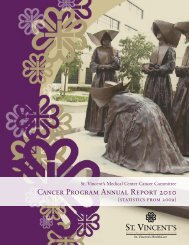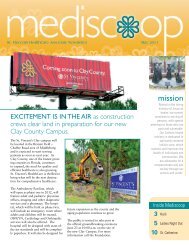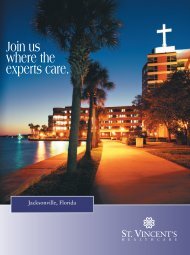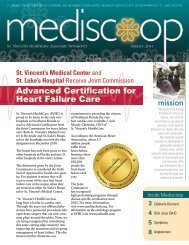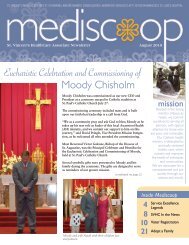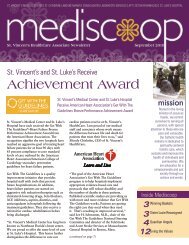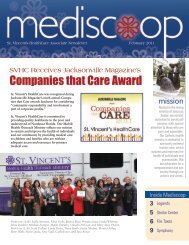Atrial Fibrillation - St. Vincent's HealthCare
Atrial Fibrillation - St. Vincent's HealthCare
Atrial Fibrillation - St. Vincent's HealthCare
Create successful ePaper yourself
Turn your PDF publications into a flip-book with our unique Google optimized e-Paper software.
<strong>Atrial</strong> <strong>Fibrillation</strong><br />
A Patient Education Handbook
Thank you for taking the time to read this patient<br />
education handbook about <strong>Atrial</strong> <strong>Fibrillation</strong>. After<br />
you have reviewed the information, you may have<br />
questions and want to learn more about <strong>St</strong>. Vincent’s<br />
<strong>Atrial</strong> <strong>Fibrillation</strong> Institute. The institute is a unique<br />
partnership of cardiologists, cardiac surgeons and<br />
<strong>St</strong>. Vincent’s <strong>HealthCare</strong>. Using a treatment protocol<br />
designed by our physicians, the <strong>Atrial</strong> <strong>Fibrillation</strong> Institute’s<br />
goal is to find a cure to AFIB for as many patients as<br />
possible. To learn more, call the <strong>Atrial</strong> <strong>Fibrillation</strong><br />
Institute or log onto our website. Information on the<br />
website includes video interviews with physicians<br />
about treatments that are available, as well as video<br />
segments of the procedures they perform for patients<br />
with <strong>Atrial</strong> <strong>Fibrillation</strong>. We are excited about the<br />
opportunity to help patients who have this heart<br />
rhythm condition and, for as many as possible, to<br />
end AFIB once and for all.<br />
904–308–AFIB<br />
afibjax.com<br />
2 A t r i a l F i b r i l l a t i o n • A P a t i e n t E D U C A T I O N H a n D b o o k
What is <strong>Atrial</strong> <strong>Fibrillation</strong>?<br />
<strong>Atrial</strong> fibrillation is the most common sustained heart rhythm disorder. Normally the heartbeat<br />
originates in the sinus node and spreads in an organized fashion throughout top chambers<br />
(atria) of the heart. Each of these regular impulses is conducted to the bottom chambers of<br />
the heart (ventricles). In atrial fibrillation, the top of the heart has rapid and chaotic activity,<br />
resulting in a loss of the squeezing function within the atria and this can result in the formation<br />
of blood clots that are an important cause of stroke. Furthermore, the bottom of the heart<br />
tends to beat rapidly and irregularly, leading to symptoms of fatigue, weakness, shortness of<br />
breath and palpitations.<br />
What are the symptoms and dangers of<br />
<strong>Atrial</strong> <strong>Fibrillation</strong>?<br />
At the same time the top of the heart has rapid and chaotic activity during <strong>Atrial</strong> <strong>Fibrillation</strong>,<br />
the bottom of the heart tends to beat rapidly and irregularly. All of this can result in symptoms<br />
that include fatigue, weakness, shortness of breath, palpitations, irregular heart beat, chest<br />
discomfort and dizziness. It should be noted that some people with AF do not experience<br />
any symptoms at all. Regardless, anyone with this condition – with or without symptoms –<br />
is at risk of one of its most dangerous side effects. <strong>Atrial</strong> <strong>Fibrillation</strong> is the most common<br />
cause of stroke.<br />
What Causes <strong>Atrial</strong> <strong>Fibrillation</strong>?<br />
Often, the exact cause of AF is difficult to determine, but we know there are certain risk<br />
factors, including hypertension, diabetes, obesity and alcohol use. Additional risk factors are<br />
structural abnormalities of the heart, such as heart valve disease, coronary artery disease,<br />
previous heart attacks and congestive heart failure. There are also some reversible causes<br />
of AF. These include thyroid abnormality, pneumonia, pulmonary embolism and recent heart<br />
surgery. In these cases, <strong>Atrial</strong> <strong>Fibrillation</strong> may resolve with treatment of the underlying cause.<br />
The incidence of AF rises sharply with age. Estimates are that as many as 2 percent of all<br />
Americans are currently experiencing <strong>Atrial</strong> <strong>Fibrillation</strong> and that up to 20 percent will<br />
experience it during their lifetime.<br />
A t r i a l F i b r i l l a t i o n i n s t i t u t e • 9 0 4 – 3 0 8 – A F I B • A F I B J A X . c o m 3
How is <strong>Atrial</strong> <strong>Fibrillation</strong> Diagnosed?<br />
The first step in diagnosing AF is a thorough medical history and physical exam. Your<br />
doctor will need to know about your symptoms and will ask you to share when your<br />
symptoms began, how long they last and how they make you feel. In addition, your doctor<br />
may choose to use tests to diagnose your condition, including one or more of the following:<br />
Electrocardiogram (ECG or EKG)<br />
An electrocardiogram is a simple test that records your heart’s electrical activity. Electrodes<br />
are placed on the arms and chest and connected to a machine that records electrical<br />
activity. The recording of that electrical activity is printed out on graph paper, and the<br />
report is interpreted by a physician.<br />
Electrophysiology (EP) <strong>St</strong>udy<br />
An EP study is performed by an electrophysiologist – a cardiologist who specializes in<br />
heart rhythm disorders – and can help confirm the type of rhythm problem you have. It is<br />
a minimally invasive procedure that usually takes place under light sedation. Electrode<br />
catheters introduced through a blood vessel are used to stimulate the heart with electrical<br />
impulses. The electrical activity of your heart during the test is recorded, and that is used<br />
to determine the best treatment options.<br />
Holter Monitor<br />
A Holter Monitor is a small portable device that makes a recording of your heart’s electrical<br />
activity over an extended period of time – 24 to 48 hours. This information can be used to<br />
detect a rhythm problem that may occur intermittently.<br />
Tilt-table test<br />
Patients who experience symptoms such as fainting or light-headedness may be scheduled<br />
for a tilt-table test. The test is used to monitor your blood pressure, heart rate and heart<br />
rhythm as you are moved from a horizontal to an upright position.<br />
4 A T R i a l F i b r i l l a t i o n • A P a t i e n t E D U C A T I O N H a n D b o o k
Normal Rhythm of a Healthy Heart<br />
Here’s how the heart’s rhythm is supposed to happen:<br />
In a normal heart, blood flows into the right side of the heart and is then pumped out<br />
to the lungs to receive oxygen. Once that happens, the blood enters the left side of the<br />
heart, which pumps the blood out through the aorta and into the body. Once oxygen<br />
has been delivered to all organs in the body, the blood flows back to the right side of<br />
the heart. The normal healthy cycle begins again.<br />
What keeps this cycle going is the heart’s electrical system. In normal heart rhythm<br />
(called “sinus rhythm”), the sinoatrial (SA) node (green oval) is the heart’s pacemaker<br />
and it starts an electrical impulse that travels to the atrioventricular (AV) node (orange<br />
oval). The AV node keeps electrical watch for the ventricles, regulating which electrical<br />
impulses are allowed through. Once electrical impulses reach the ventricles, that causes<br />
the lower heart chambers to contract and pump blood out to the body.<br />
A t r i a l F i b r i l l a t i o n i n s t i t u t e • 9 0 4 – 3 0 8 – A F I B • A F I B J A X . c o m 5
Abnormal Rhythm of a Heart with<br />
<strong>Atrial</strong> <strong>Fibrillation</strong><br />
Here’s how the heart’s rhythm is interrupted by AF:<br />
Abnormal electrical impulses originate in the left atrium around the SA node (red, upper<br />
left) and around the pulmonary veins (red arrows, upper right). These impulses are<br />
chaotic and travel throughout the atria. This forces the heart’s upper chambers to<br />
contract so quickly – they appear to quiver rather than to beat.<br />
As it keeps electrical watch for the ventricles, the AV node (red, upper center) does<br />
its best to protect the lower chambers from this bizarre electrical activity, but some of<br />
the chaotic impulses make it past. This forces the heart to beat very rapidly, irregularly<br />
and ineffectively.<br />
6 A T R i a l F i b r i l l a t i o n • A P a t i e n t E D U C A T I O N H a n D b o o k
How Can <strong>Atrial</strong> <strong>Fibrillation</strong> Be Treated?<br />
MEDICATIONS<br />
The first goal in treatment of atrial fibrillation is stroke prevention. For many patients, this means use<br />
of the blood thinner warfarin (Coumadin). Use of warfarin requires careful blood test monitoring, but<br />
will prevent the majority of strokes from atrial fibrillation. Taking blood thinners has risks, but multiple<br />
research studies show that the benefits of stroke prevention far outweigh these risks. At the <strong>Atrial</strong><br />
<strong>Fibrillation</strong> Institute, we also have investigational blood thinners available as part of research trials<br />
that have some practical advantages over warfarin and we can assess your candidacy for these<br />
trials if you would like. There are other patients whose age, medical history and infrequency of atrial<br />
fibrillation episodes suggest low stroke risk and aspirin may be used. Finally, some patients may not<br />
be good warfarin candidates because they are at very high risk of serious bleeding, cannot get<br />
follow-up blood tests or are at high risk for falls. It is important to understand that aspirin provides<br />
much less stroke protection than warfarin, but is the next best alternative. Recent data has shown that<br />
clopidogrel (Plavix) is another blood thinner that can be added to aspirin for an intermediate level<br />
stroke risk reduction if warfarin cannot be taken.<br />
The second goal of treatment involves alleviating the symptoms of atrial fibrillation. This can be done<br />
by allowing atrial fibrillation to persist, but controlling the heart rate. This strategy involves the use of<br />
beta-blockers, calcium channel blockers, and digoxin — either alone or in combination. Rarely,<br />
implantation of a pacemaker with a relatively simple procedure called “AV junction ablation” is<br />
helpful, but results in the patient being “dependent” on a pacemaker for their basic heart rhythm.<br />
ELECTRICAL CARDIOVERSION<br />
The other key approach to controlling symptoms in atrial fibrillation is to maintain sinus rhythm. Some<br />
patients bounce in and out of atrial fibrillation on their own (called “paroxysmal” atrial fibrillation)<br />
while others will stay in “persistent” atrial fibrillation. In the case of persistent atrial fibrillation, a<br />
patient can be converted to sinus rhythm with a simple procedure called a cardioversion. This is<br />
usually done with a small shock that jolts the heart into normal rhythm while the patient is under<br />
anesthesia. Often this procedure may be combined with a trans-esophageal echo (TEE) when it is<br />
necessary to exclude the possibility of blood clots in the heart.<br />
A t r i a l F i b r i l l a t i o n i n s t i t u t e • 9 0 4 – 3 0 8 – A F I B • A F I B J A X . c o m 7
Our Patients<br />
Lillian Butler-Humphries,<br />
<strong>Atrial</strong> <strong>Fibrillation</strong> patient<br />
treated at <strong>St</strong>. Vincent’s.<br />
Lillian Butler-Humphries is a 60-year-old active woman<br />
who says <strong>Atrial</strong> <strong>Fibrillation</strong> caused her to be extremely<br />
tired much of the time. For a woman who loves to<br />
be constantly on the go, AFIB was life altering. She<br />
was often short of breath and experienced what she<br />
describes as ‘the flutters.’<br />
“It’s hard to describe exactly how my<br />
heart felt when I had AFIB,” says Butler-<br />
Humphries. “You just knew you weren’t<br />
supposed to feel this way. It’s like your<br />
heart races when you run and calms<br />
down when you stop running. When<br />
you have AFIB, your heart keeps racing<br />
even after you stop and sit down.<br />
It’s scary.”<br />
Gerald Burns is a 61-year-old<br />
man whose passions are spending<br />
time with his wife and riding<br />
his bicycle. In a good year, Burns<br />
would ride 10,000 miles. Some<br />
of the medication he took for <strong>Atrial</strong><br />
<strong>Fibrillation</strong> made that impossible.<br />
“Some of the medicine would make me<br />
just sit on the couch and stare,” Burns<br />
remembers. “Later, my doctors did find a<br />
medicine that was not so bad, but I still<br />
never felt like myself – good enough to<br />
do all the things I love to do.”<br />
Both Lillian and Gerald found answers to their heart<br />
rhythm disorder at <strong>St</strong>. Vincent’s, where they had catheter<br />
ablation procedures. Nearly six months after those<br />
procedures, neither had experienced <strong>Atrial</strong> <strong>Fibrillation</strong><br />
and hoped they would soon be able to stop taking<br />
medication altogether.<br />
“I am back on my bike, back to work, and I feel great,”<br />
Burns says. While he won’t be able to complete 10,000<br />
miles this year on his bicycle, Burns plans to go as far<br />
as he can.<br />
Butler-Humphries says she was once an avid walker<br />
before <strong>Atrial</strong> <strong>Fibrillation</strong> took away her energy. Now,<br />
she says she is ready to take distance walking up again.<br />
She is also considering joining a gym and is enjoying<br />
thinking about all of the things she can do now. “I love<br />
my life,” Butler-Humphries says. “And I am going to live it.”<br />
Gerald Burns, <strong>Atrial</strong><br />
<strong>Fibrillation</strong> patient<br />
treated at <strong>St</strong>. Vincent’s.<br />
Lillian Butler-Humphries and Gerald Burns<br />
both experienced the frustration of living<br />
with <strong>Atrial</strong> <strong>Fibrillation</strong>. They have also both<br />
experienced successful treatment for their<br />
heart rhythm disorder at <strong>St</strong>. Vincent’s.<br />
8 A T R i a l F i b r i l l a t i o n • A P a t i e n t E D U C A T I O N H a n D b o o k
Anthony Magnano, MD Saumil Oza, MD ARNE SIPPENS, MD<br />
Catheter Ablation<br />
When at least one medication fails to control symptoms of atrial fibrillation, catheter ablation<br />
is advocated by the American Heart Association, American College of Cardiology and the<br />
Heart Rhythm Society for suitable patients. Because atrial fibrillation is a complex heart rhythm<br />
that can involve multiple regions of the heart, catheter ablation of atrial fibrillation is somewhat<br />
more complex than many other catheter ablation procedures.<br />
A t r i a l F i b r i l l a t i o n i n s t i t u t e • 9 0 4 – 3 0 8 – A F I B • A F I B J A X . c o m 9
Catheter Ablation<br />
Experience and collaboration among doctors from all over the world led to rapid advances in atrial fibrillation<br />
ablation. The most common procedure now involves encircling all 4 pulmonary veins to prevent the impulses<br />
that could initiate and perpetuate atrial fibrillation from ever getting to the rest of the heart. In some patients,<br />
additional ablation may be required if triggers or mechanisms for atrial fibrillation involve regions outside of<br />
the pulmonary veins. If atrial fibrillation continues uninterrupted for a long period of time, it may promote<br />
multiple areas of the heart to perpetuate atrial fibrillation and it may become more difficult to ablate all of<br />
these areas.<br />
SINGLE PROCEDURE SUCCESS RATES IN PAROXYSMAL ATRIAL FIBRILLATION<br />
Approximately 70% of patients have no atrial fibrillation seen and are off antiarrhythmic drugs at 6-12 months<br />
after a single procedure. Many additional patients have a clinical benefit even though episodes of atrial fibrillation<br />
may occasionally occur. Such patients typically have a reduced frequency of atrial fibrillation episodes<br />
or are now easily controlled by medications that didn’t work prior to ablation. Some patients (long-standing<br />
atrial fibrillation and/or more significant associated heart disease) have more difficulty to treat variants of<br />
atrial fibrillation and we may have somewhat lower success rates.<br />
REPEAT PROCEDURES<br />
Can be considered if results of first procedure do not meet our treatment goals and will improve the overall<br />
success rates.<br />
STOPPING WARFARIN<br />
<strong>St</strong>opping Warfarin is considered on a case-by-case basis depending on the patient’s risk of stroke.<br />
10 A T R i a l F i b r i l l a t i o n • A P a t i e n t E D U C A T I O N H a n D b o o k
Raymond Lee, MD, and<br />
Mark Mostovych, MD<br />
Surgical Ablation<br />
For some patients with paroxysmal <strong>Atrial</strong> <strong>Fibrillation</strong>, surgical ablation<br />
may be an option. In this procedure, a physician applies energy to the<br />
outside of the heart, creating a lesion or scar that blocks abnormal<br />
electrical signals that cause AF. Patients who undergo cardiac surgery<br />
such as a valve replacement or coronary artery bypass graft (CABG),<br />
may be advised to receive surgical ablation for <strong>Atrial</strong> <strong>Fibrillation</strong> at the<br />
same time. Surgical ablation is performed by cardiothoracic surgeons<br />
Raymond Lee, MD, and Mark Mostovych, MD in the operating rooms<br />
of <strong>St</strong>. Vincent’s Medical Center.<br />
A t r i a l F i b r i l l a t i o n i n s t i t u t e • 9 0 4 – 3 0 8 – A F I B • A F I B J A X . c o m 11
Surgical Ablation<br />
During surgical ablation for <strong>Atrial</strong> <strong>Fibrillation</strong>, a small incision is made between the<br />
ribs on the right side of the chest. Doctors use a cinch-like device that encircles the<br />
atrium to deliver high intensity ultrasound. If necessary to reach tissue outside the<br />
pulmonary vein area, they use radiofrequency clamps. Both produce ablation lines<br />
through the targeted tissue.<br />
For ideal candidates who have structurally normal hearts, 85 to 90 percent no longer<br />
experience AF after the surgical ablation procedure. For patients who have chronic<br />
AF with hearts that are enlarged, the cure rate drops down to about 60 percent.<br />
12 A T R i a l F i b r i l l a t i o n • A P a t i e n t E D U C A T I O N H a n D b o o k
My Doctor<br />
Notes<br />
The <strong>Atrial</strong> <strong>Fibrillation</strong> Institute<br />
904-308-AFIB<br />
afibjax.com<br />
A t r i a l F i b r i l l a t i o n i n s t i t u t e • 9 0 4 – 3 0 8 – A F I B • A F I B J A X . c o m 13
Notes<br />
14 A T R i a l F i b r i l l a t i o n • A P a t i e n t E D U C A T I O N H a n D b o o k
IMportant Information<br />
<strong>St</strong>. Vincent’s Medical Center<br />
Main Line<br />
904–308–7300<br />
<strong>St</strong>. Vincent’s<br />
Gary and Nancy Chartrand<br />
Heart & Vascular Center<br />
903–308–8141<br />
800–825–8485<br />
<strong>St</strong>. Vincent’s HealthLINK<br />
Physician referral and nurse help line<br />
904–308–LINK or 800–226–LINK<br />
<strong>St</strong>. Luke’s Hospital<br />
Main Line<br />
904–296–3700<br />
<strong>St</strong>. Vincent’s Cardiopulmonary<br />
Rehabilitation<br />
904–308–7560<br />
Waycross Cardiology Clinic<br />
912–285–3086<br />
Charlton Specialty Clinic<br />
912–496–4827<br />
ATRI a L FIBRILL a TION • A P a TIENT H a NBOOK 2
THE ATRIAL FIBRILLATION INSTITUTE<br />
904–308–AFIB • afibjax.com




